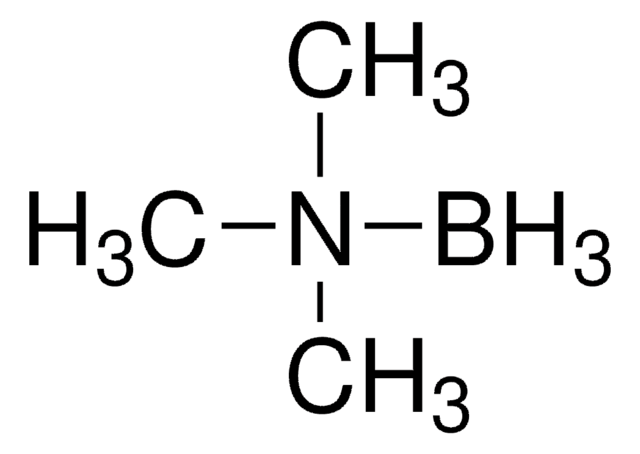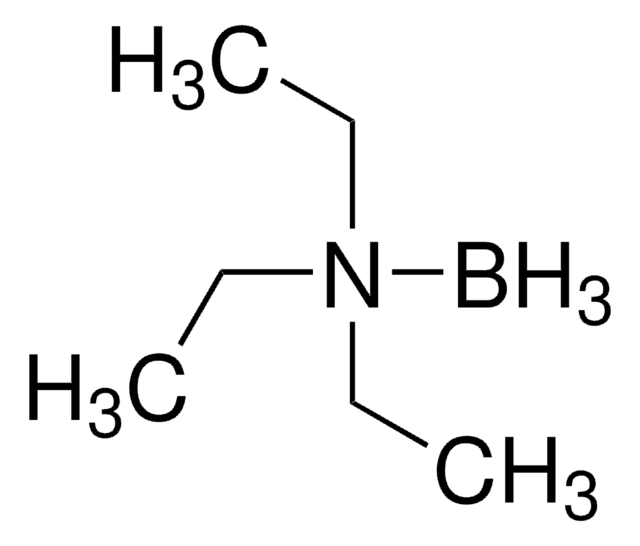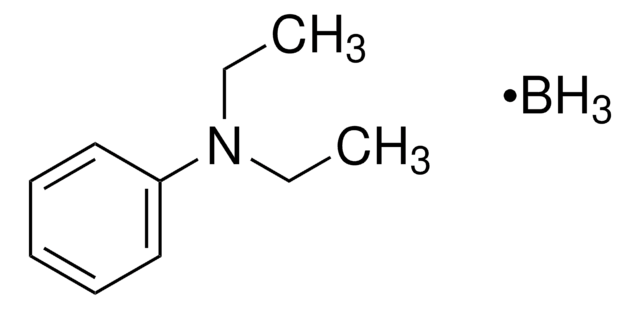179752
Borane pyridine complex
~8 M BH3
Sinonimo/i:
NSC 10219, NSC 53324, Pyridine borane, Trihydro(pyridine)boron
Autenticatiper visualizzare i prezzi riservati alla tua organizzazione & contrattuali
About This Item
Formula empirica (notazione di Hill):
C5H8BN
Numero CAS:
Peso molecolare:
92.93
Numero MDL:
Codice UNSPSC:
12352005
eCl@ss:
39151701
ID PubChem:
NACRES:
NA.22
Prodotti consigliati
Forma fisica
liquid
Livello qualitativo
Impiego in reazioni chimiche
reagent type: reductant
Concentrazione
~8 M BH3
Indice di rifrazione
n20/D 1.532 (lit.)
Punto di fusione
10-11 °C (lit.)
Densità
0.92 g/mL at 25 °C (lit.)
Temperatura di conservazione
2-8°C
Stringa SMILE
[BH3-][n+]1ccccc1
InChI
1S/C5H8BN/c6-7-4-2-1-3-5-7/h1-5H,6H3
LPGWNCNRGQANGC-UHFFFAOYSA-N
Applicazioni
Borane pyridine complex is commonly used as a reducing reagent for the reductive amination of aldehydes and ketones. It is the precursor to synthesize carbon-based material, BC4N. Along with iodine, it can be used as a reagent for hydroboration of alkenes and alkynes.
Used for:
Reducing agent for high performance liquid chromatography analysis of oligosaccharides
Modifier in decant oil affecting its carbonization to mesophase pitch
- Investigations of site energy distribution functions from Toth isotherm for adsorption of gases on heterogeneous surfaces
- Preparation of α−alkyl-β-hydroxy esters
- Regioselective immobilization of short oligonucleotides to acrylic copolymer gels
- Preparation of Igs conjugated with viral peptide epitopes
- Sintering of silicon carbide
Reducing agent for high performance liquid chromatography analysis of oligosaccharides
Modifier in decant oil affecting its carbonization to mesophase pitch
Avvertenza
May darken in storage.
Altre note
may contain excess pyridine
Avvertenze
Danger
Indicazioni di pericolo
Classi di pericolo
Acute Tox. 1 Inhalation - Acute Tox. 3 Dermal - Acute Tox. 3 Oral - Eye Irrit. 2 - Flam. Liq. 2 - Skin Irrit. 2
Codice della classe di stoccaggio
3 - Flammable liquids
Classe di pericolosità dell'acqua (WGK)
WGK 3
Punto d’infiammabilità (°F)
69.8 °F
Punto d’infiammabilità (°C)
21 °C
Scegli una delle versioni più recenti:
Possiedi già questo prodotto?
I documenti relativi ai prodotti acquistati recentemente sono disponibili nell’Archivio dei documenti.
I clienti hanno visto anche
A novel carbon material derived from pyridine-borane.
Riedel, Ralf et al.
Advanced Materials, 3(11), 551-552 (1991)
T Miron et al.
Analytical biochemistry, 440(1), 12-14 (2013-05-28)
In this note, we describe a method devised to detect, by means of mass spectrometry (MS), tryptophan-containing peptides and proteins using pyridine-borane. This reagent selectively reduces tryptophan residues, converting them to 2,3-dihydro-tryptophan, thereby enabling quantitation of tryptophans.
Journal of the Chemical Society. Perkin Transactions 1, 717-717 (1984)
Jethro L Hemmann et al.
Proceedings of the National Academy of Sciences of the United States of America, 116(51), 25583-25590 (2019-11-30)
Methylotrophy, the ability of microorganisms to grow on reduced one-carbon substrates such as methane or methanol, is a feature of various bacterial species. The prevailing oxidation pathway depends on tetrahydromethanopterin (H4MPT) and methylofuran (MYFR), an analog of methanofuran from methanogenic
Hydroboration with pyridine borane at room temperature.
Clay, Julia M and Vedejs, Edwin
Journal of the American Chemical Society, 127(16), 5766-5767 (2005)
Il team dei nostri ricercatori vanta grande esperienza in tutte le aree della ricerca quali Life Science, scienza dei materiali, sintesi chimica, cromatografia, discipline analitiche, ecc..
Contatta l'Assistenza Tecnica.










